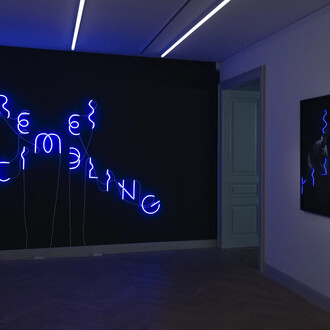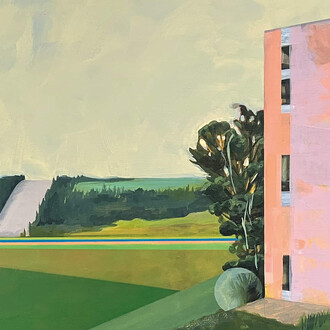Emil Nolde is considered a leading representative of expressionism and one of the most well-known artists of the 20th century. His work is widely known for its extraordinary intensity of colour. Nolde explored the grotesque, the fantastic and the exotic in order to develop his own pictorial language and escape from the European tradition of art. This exhibition presents a selection of 170 works by the artist and sheds light on these and other themes in his oeuvre.
The Zentrum Paul Klee is dedicating its winter exhibition of 2018/19 to Emil Nolde, portrayed by Klee as a “Nordic” artist. Nolde and Klee were contemporaries as well as friends who regularly visited and corresponded with each other during the 1920’s and 1930’s. For Nolde’s 60th birthday, Klee penned a laudatory text for a commemorative volume that was published in 1927. Although Klee’s artistic self-definition as an “ethereal” artist stood in direct opposition to Nolde’s “earthy” persona, he nevertheless felt a strong affinity for him. “Nolde is more than just terrestrial”, Klee wrote, “he is also the demon of that region. Dwelling elsewhere myself, one always feels one’s cousin down there on earth, a kindred spirit.” Likewise, Nolde acknowledged: “We were very different, but his absolute recognition of my art, although he painted very differently from me, was wonderful.” At first sight, both artists’ works certainly share more differences than similarities.
The purpose of the exhibition at the Zentrum Paul Klee is not to compare the two artists, as their aesthetics are too divergent. Rather, we are concentrating on the common themes that run through both artists’ oeuvres. For instance, they shared a fascination with the grotesque, the fantastic and the exotic. Both artists embraced the grotesque as a means to cast a critical eye on current events. However, Nolde abandoned all expectations and preconceived ideas in his images, whereas for Klee the realm of ghosts, demons and other hybrid creatures offered a fascinating alternative universe. In the early twentieth century, the exotic – or that which stood outside of European tradition – presented Klee, Nolde and many of their contemporaries with a compelling new formal language.
Beginning with the 'Mountain Caricatures' that Nolde created during his stay in Switzerland at the turn of the 19th century, the exhibition designates additional sections to the works from his solitary ventures to the peninsula of Jutland. The exhibition also showcases Nolde’s caricatures of Berlin nightlife from around 1911. Although Nolde frequently spent his evenings in dance clubs, he devoted his days to the study of non-Western art at the Royal Museum for Ethnology. His sketches formed the basis of a series of still lives characterized by unorthodox juxtapositions of objects from disparate cultures. Along these lines, we are also dedicating a section to Nolde’s journey to the South Pacific from 1913-1914. The watercolours and paintings he made on site as well as works he later produced on the basis of his experience convey Nolde’s ambivalent attitude towards the cultural “other”. On the one hand, the artist was fascinated by the ostensibly unspoiled nature of the region’s native peoples, which seemed untouched by European tradition. On the other, he feared what he perceived as their savagery, and thus confirmed the prejudice current at the time.
Regardless of how Nolde encountered the unfamiliar or the “other,” it helped him to advance his work and liberate it from norms and customs. Inspired by the uncanny, Nolde developed an unparalleled oeuvre that is distinct from those of his contemporaries. This was especially true during the National Socialist period when Nolde was barred from working. The artist, who thought of himself as a truly German painter and could not comprehend why the Nazis branded his modern art as “degenerate,” responded with his series of “Unpainted Pictures.” At that time, Nolde often and unsurprisingly retreated to a fantasy world that conjured countless ghosts and fantastic creatures.
A chronology with archival documents will give insight into the encounters between Nolde and Klee as well as their common exhibitions and friends.
The exhibition is organized in close cooperation with the Nolde Foundaiton in Seebüll. A bilingual catalogue will be published by the Snoeck Verlag, and will include the correspondence between the Nolde and Klee and their respective families.






![Gego, Bicho 89/17 [Bug 89/17], 1989. Courtesy of Zentrum Paul Klee](http://media.meer.com/attachments/f079a1f4646d2c18046e435b0d7c6a40c4d590ab/store/fill/330/330/15240f8a7c2620c149272c56d3458458d719746e821a8c6a92e906b56287/Gego-Bicho-89-slash-17-Bug-89-slash-17-1989-Courtesy-of-Zentrum-Paul-Klee.jpg)


![Karel Appel, Le coq furieux [The furious rooster] (detail), 1952. Courtesy of Kunstmuseum Bern](http://media.meer.com/attachments/de322f88933729d2014dc4e021d4a6694046a744/store/fill/330/330/c26a6c5ef5e2ed397d4a2e9bc00ac739c40ba8384f45f9ce1ed85adba600/Karel-Appel-Le-coq-furieux-The-furious-rooster-detail-1952-Courtesy-of-Kunstmuseum-Bern.jpg)
![Ernst Ludwig Kirchner, Sonntag der bergbauern [Mountain peasants
on sunday] (detail), 1923-24/26. Courtesy of Kunsthalle Bern](http://media.meer.com/attachments/20a8137ccad773c13862ccdfc875e8e9140e882a/store/fill/330/330/2b752c5aa2aa5dd58dbb48294877d0648612d2f7494bb2ea5052c0c3ef43/Ernst-Ludwig-Kirchner-Sonntag-der-bergbauern-Mountain-peasants-on-sunday-detail-1923-24-slash-26.jpg)
![Arnold Böcklin, Meeresstille [Calm sea], 1887. Courtesy of Kunstmuseum Bern](http://media.meer.com/attachments/31f0fbf5fc85bf4c4f3420830f31c3f397dc0c0a/store/fill/330/330/9f1e7907383dd5889d45b340467c7e560675e5ed70f1c887e82a3da16e45/Arnold-Bocklin-Meeresstille-Calm-sea-1887-Courtesy-of-Kunstmuseum-Bern.jpg)




